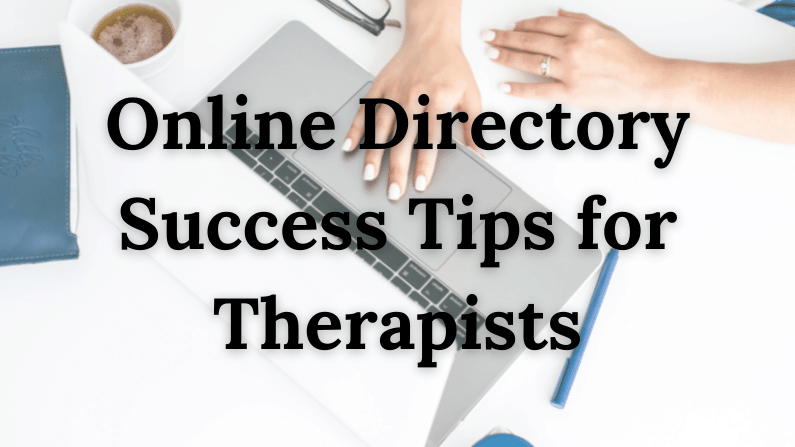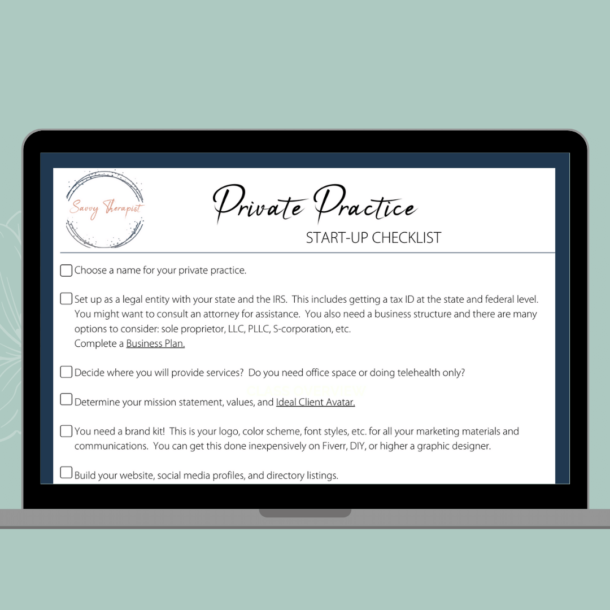As therapists, we all know about the online directories like Psychology Today, Mental Health Match, or Good Therapy. Online directories have long been a staple of marketing for therapists and a great tool for clients alike!
However, very few therapists are taught the skills of online marketing or copy writing and struggle with what to write in these profiles. Unfortunately, that means most of the profiles are mediocre and don’t function as the revenue generator they should be.
This article is going to serve as a guide for writing an awesome online profile for your favorite directory or listing service.
Why Online Directories?
No matter where you are at in your private practice building journey, you can benefit from a listing on a reputable directory. It makes it easy for clients to find you and initiate contact. Larger more well known directories like Psychology Today are often ranked #1 for therapy seekers on the hunt for a therapist.
If you can’t afford a fancy website, Google ads, or you hate tech and need to get clients quickly, directories are a good alternative to generate referrals. Just make sure the investment in the directory is outweighed by the revenue generated by client referrals on the platform. You can be choosy, you don’t need to be listed everywhere! That gets expensive and once your practice grows, often completely unnecessary.
Because many clients recognize platforms like Psychology Today this can help build credibility if you are a new therapist just starting out or heading into private practice.
The Areas of Biggest Impact
A lot of detail is required to create a great online profile, but we are going to focus on the areas of biggest impact, so your profile listing starts generating referral for your practice as quickly as possible.
Photos
Your photo is one of the first things client see when they find you online. It is often said that a picture is worth a thousand words. That advice is still true when it comes to your online directory listings.
Invest in professional photos or make sure your photo is the best version of how you show up in therapy for your clients. If you aren’t ready to invest in professional photos right now, at the very least try to fake one!
Make sure you take your photo in good lighting with a neutral or pleasant background. Use a photo that is relevant and relatable without heavy filters. Always remember to keep those photos classy and professional.
Remember the importance of trying to portray yourself as you would show up in therapy. It makes you more relatable, gives the client a better idea what to expect, and attracts clients that prefer your style or approach.
Remember to update your photos as you change your style and look. No one likes outdated photos!
Personal Statement
Write to your ideal client! I can’t tell you how often I read profiles where the therapist only talks about themselves and the therapeutic approaches they utilize. This is boring for clients. Why? They don’t care about your high level theories.
Clients care about how your work together makes them FEEL and the RESULTS they get from working with you. Clients want to achieve a result and want to know if you can help them on that journey.
Although informative, your theory and approach likely won’t connect with the client or build any rapport.
Instead, focus on the presenting problem, illustrate you understand the struggle, offer hope.
Consider the following…
- How do your ideal clients feel and what do they hope to get out of the therapy process?
- How can you help them?
- What increases a sense of safety and trust?
Get specific here! Don’t shy away from talking to your niche. We aren’t a good fit for all therapy clients and that is OKAY. If you feel the best when working with couples, then double down on speaking to that audience in your profile.
This doesn’t mean you can’t help someone who isn’t the focus of your profile. If you speak in only generalities, you don’t stand out in a sea of similar listings. Be brave, and get detailed about who you best help.
If you speak to everyone, it is too general and no one feels connected to your message. Often trying to generalize or cast a wider net regarding clients we work with is a result of SCARCITY mindset. You want to show up authentically. There are PLENTY of clients to go around.
Specialties
Narrow it down! Less can be better in many situations. Don’t be too broad and check off every mental health diagnosis you’ve ever made or any modality you’ve ever trained in. Keep the list short and pick your favorites. These should be the modalities and issues that you are most skilled in and use everyday in your practice.
You want to attract clients you like to work with, and clients who are a good fit for your practice as well.
If you market to everyone out of a scarcity mindset, afraid you are limiting your potential client pool then you are underestimating the value of a well crafted message that resonates with the right audience.
Finances
Be clear about your rates, if you accept a sliding fee, and keep your list of insurers you work with up to date!
There is nothing worse than reaching out to a potential therapist only to find they have outdated listings for insurance and no longer accept your plan or their cash rates have not been kept current.
There are a lot of nuances regarding insurance plans. Make sure you are specific, and explain your policies for billing and insurance if you accept it.
A little work on the front end to make fees clear and set boundaries around payment for services helps the process go smoothly for both client and therapist alike.
Bonus Tips
LOCATION settings are very important. Make sure you are targeting the geographical area that is most relevant to your practice or where you are trying to find clients. You can switch this up if you are a virtual practice or have a practice in a metro area heavily saturated with therapist profiles. Try different options to see what performs best and what zip codes you have better results marketing in.
RESPOND to clients in a reasonable timeframe if they reach out to you on directory listings. It is not fun as a client to get the courage to reach out to someone for therapy then be left with no response.
You can also miss out on clients by waiting too long because they move on to the next therapist on the list. Make sure you have a system for responding. If you have a full practice you can update that information in your online listings so clients are not reaching out and subsequently upset or disheartened when you have a waitlist.
A little human kindness goes a long way here! I have heard so many stories from clients about their struggles seeking a therapist who was a good fit. Sending out email after email, calling repeatedly, and not getting any response.
Noting upfront on your profile that you are full or not accepting clients helps reduce response time!
Final Thoughts
As a business coach and practice owner, I don’t suggest relying on directory listings alone to generate a steady stream of referrals for your practice in the long-term. You also need a solid marketing strategy that works for your personality and a web presence of your own.
If you need help with your online profiles and want to supercharge them for client conversions, book a Business Strategy Session today!



Recent Comments